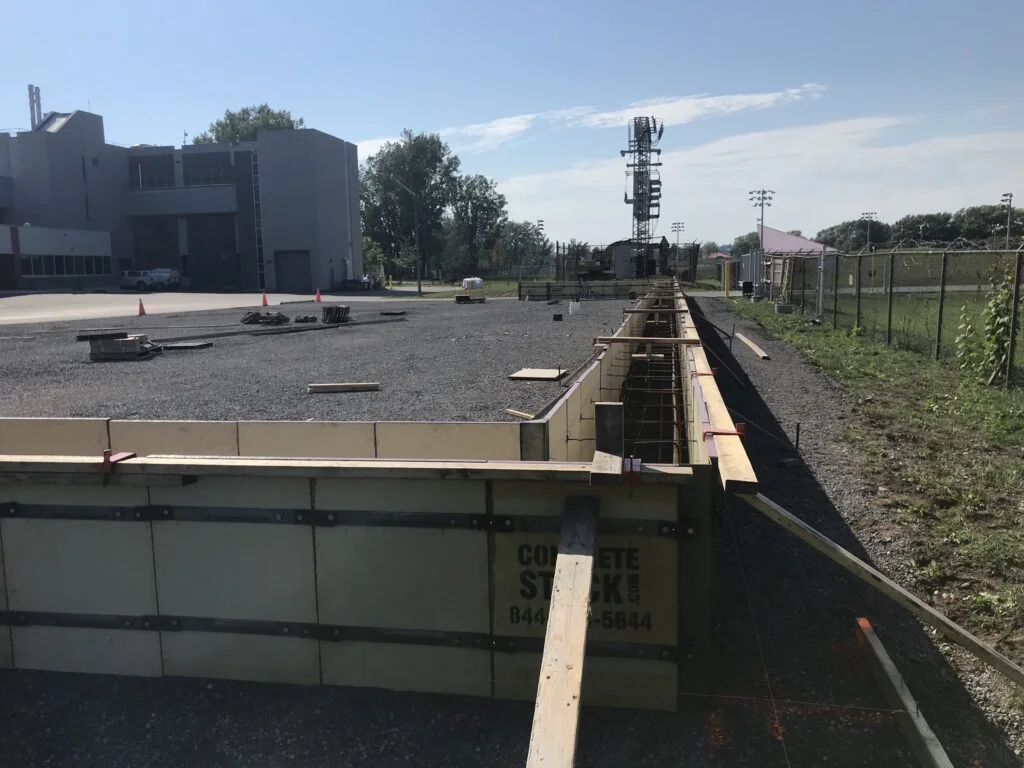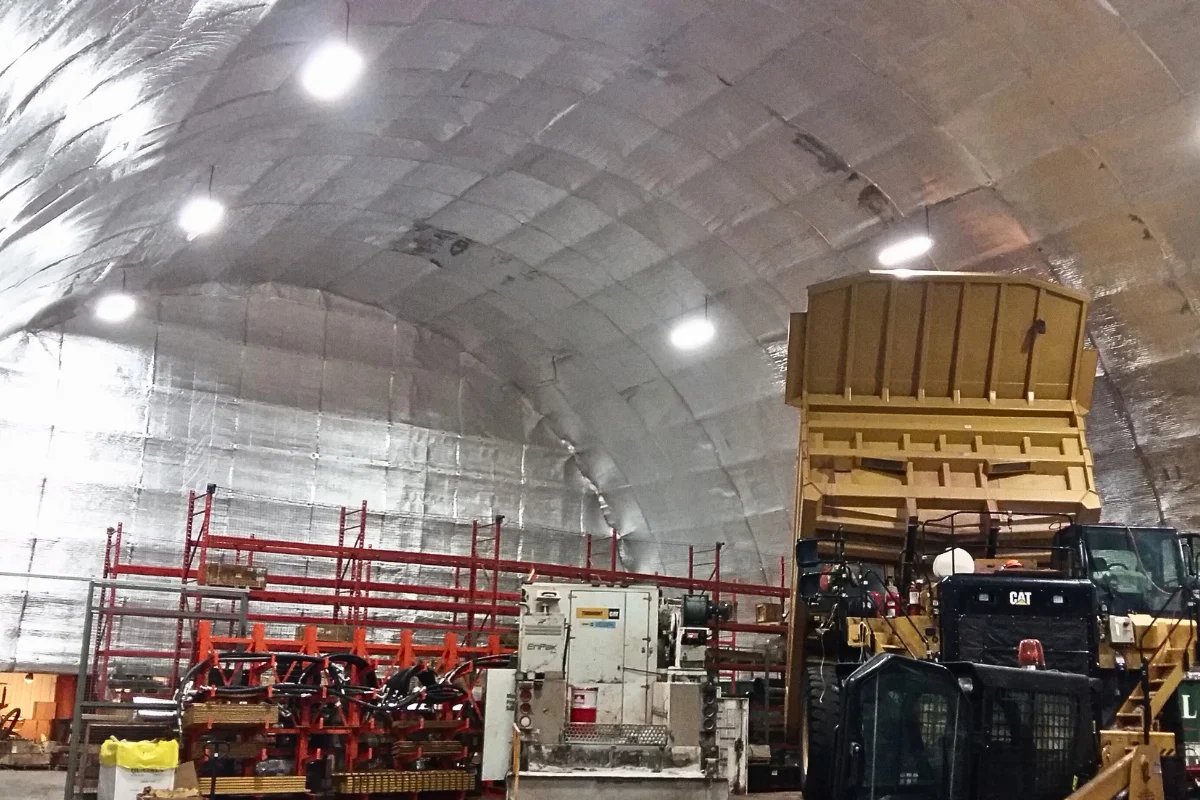Fabric Building Foundation Options You Can Trust

A great fabric building starts from the ground up. The right base supports load paths, keeps frames aligned, and protects the fabric envelope from movement over time. The wrong choice can invite settlement, door misalignment, and premature cover wear. This guide breaks down fabric building foundation options, the site factors that drive your decision, and why the base you choose has a direct impact on safety, performance, and lifecycle cost.
Reminder: Final foundation selection and detailing require review and stamped design by a licensed Professional Engineer.
What Foundation Types are Commonly Used for Fabric Buildings?
Concrete piers and pads Foundation
Individual piers or pad footings support each column location. They are efficient where soils are strong and frost protection is simple to achieve. Piers can be tied together with grade beams where lateral loads are higher.
Grade beams and strip footings
Continuous concrete beams distribute loads along the wall line, improving performance on variable soils or higher wind zones. Grade beams also provide a consistent base elevation for walls, cladding, or curb-mounted doors.
Poured slab-on-grade
A concrete foundation for fabric structure with a full slab delivers a clean, level working surface for forklifts, racking, and drainage control. Slabs can integrate anchor bolts, trench drains, and radiant heat. Many commercial and municipal clients prefer slabs for year-round operations.
Precast blocks or cast-in-place curbs
Precast concrete blocks or continuous curbs provide a quick, repeatable base with a defined edge. Blocks can raise wall height for added side clearance and help isolate the fabric from ground splash.
Helical piles
Steel helices are advanced into the soil to reach capacity, then connected to brackets or a beam. Piles shine in soft or layered soils where shallow spread footings would be oversized.
Ground screws
A ground screw fabric building foundation uses large threaded steel screws that are driven to capacity without excavation. Ground screws can speed installs, reduce spoils, and perform well in granular soils. They are also removable, which suits relocatable structures.
Temporary systems
Ballast, pins, or modular foundations can be effective for short-term needs. A temporary foundation for fabric buildings still requires proper engineering and anchorage for site wind and use. Temporary does not mean unengineered.
If you are comparing kit-style bases to engineered options, see engineered vs non-engineered fabric structures: why it matters and six essential elements in fabric structure development.
How do Site Conditions Influence the Fabric Building Foundation Choice?
Soils and bearing capacity
Every site is different. Granular, well-drained soils often support spread footings, curbs, or slabs. Soft, compressible, or fill soils may drive you toward piles, ground screws, or deeper excavation with engineered fill.
Frost depth and heave
Canadian and northern U.S. sites need frost protection. Footings are set below frost, insulated, or isolated from heave. Ignoring frost can lift one frame leg, twist door frames, and loosen fabric tension.
Drainage and moisture
Standing water undermines subgrade performance. Proper slopes, swales, and base course are part of the foundation strategy. Slabs and curbs also help by lifting fabric edges clear of splash and snow pack.
Loads and use case
High internal traffic, racking, or heavy equipment often favor a concrete foundation for fabric structure such as a slab-on-grade with reinforcement. Salt, sand, or aggregate storage may call for curbs to contain materials and protect the cover. Livestock environments lean on curbs and drainage for cleanability.
Project duration and mobility
If the building is relocatable, foundations that can be removed or reused help. This is where piles with removable heads, precast blocks, or a temporary foundation for fabric buildings can make sense.
Permitting and codes
A stamped engineered foundation for fabric building aligns your design with local codes for wind, snow, and occupancy. Foundations are not just a construction detail. They are part of the engineered system that protects people, equipment, and inventory.

Preparing the reinforced concrete grade beam foundation, a crucial step for durable fabric building construction.
Why Does the Fabric Building Foundation Matter so Much?
A strong frame needs a stable base. When foundations move, the frame goes out of plumb, fabric tension relaxes, and wear points appear at corners and door jambs. Over time that can shorten cover life, increase maintenance, and create safety risks. The right foundation:
- Keeps frames square so doors open smoothly and seals perform
- Preserves fabric tension to reduce flutter and abrasion
- Manages water and frost so the subgrade stays stable
- Lowers lifecycle cost by extending cover and frame longevity
For a deeper look at total value, see the advantages of a fabric structure and how a sound base supports ROI across decades.
How Should You Evaluate Fabric Building Foundation Options?
Start with investigation
Soil reports, frost depth, and site drainage shape the design. A quick geotech review pays off by preventing oversizing or underperformance.
Match the base to operations
Warehouse traffic and pallet jacks benefit from slabs. Commodity storage may prefer curbs and abrasion-resistant edges. Agriculture often balances cleanability, airflow, and manure handling. Explore our Agriculture and Commercial pages for typical use cases.
Think through lifecycle
If you will expand length later, consider a modular beam layout or extendable grade beam. If the building may relocate, piles or ground screws can simplify removal and site restoration.
Plan details early
Door sizes, bollards, interior drains, and conduit stub-ups are easiest to coordinate before concrete. Good detailing prevents rework and keeps the install on schedule.
Protect the asset
Sealants, edge flashing, and proper splash protection prevent corrosion and fabric wear. Routine maintenance checks keep tensions correct and anchor bolts tight.
Quick Answers to Common Questions
Which option is most cost effective?
It depends on soils, loads, and schedule. A curb or grade beam may be enough in some settings. In others, piles or screws reduce excavation and outperform spread footings. Total cost includes installation, performance, and longevity.
Can fabric building foundations be installed in winter?
Yes, with the right plan. Heaters, insulated blankets, admixtures, and prefabricated elements keep work moving. Winter installs can also benefit from frozen ground and better site access.
Do temporary fabric building foundations require engineering?
Absolutely. Temporary structures still face wind, snow, and occupancy risks. Proper anchorage and stamped designs protect people and equipment.
Are ground screws as strong as concrete?
Capacity is based on soil conditions and design. In the right soils, ground screws provide excellent tension and compression performance, with the added benefit of speed and removability for relocations.
Next Steps
The foundation is part of the building system, not an afterthought. If you are weighing fabric building foundation options for a new structure or an expansion, our team can help you select and detail the right approach for your site and use. For small properties, start by choosing the right size and style of fabric building for your hobby farm. If you are updating an existing structure, see selecting a qualified contractor for a fabric building re-cover job. Every project is engineered for its loads and location, so you get a foundation that supports performance from day one.
Explore our warranty for coverage details, or connect with a building specialist. We will review soils, use, and code requirements, then recommend the best fabric building foundation options for long-term success.

